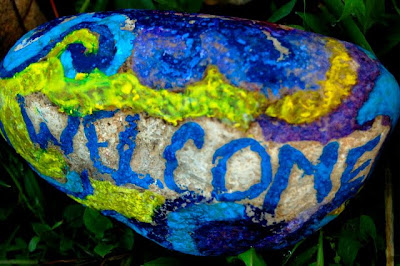I was out working in the garden on Friday evening as people were walking on the path through the garden to head to a festival a few blocks away. Most people paid little attention to the space they were walking through. One woman came in and sat at the picnic table while chatting on her phone, seeming oblivious to the gardens, birds and insects all around her. Another swiped a few raspberries from the bushes as she walked by.
Just one group, two young women and a young man, probably all in their mid twenties walked by talking about the space. The one young woman was asking questions about the garden, how it was used and managed. She laughed that she loved it because she is a hippy at heart. The other woman was less complimentary. She said she'd like to take a weed eater to the whole thing. She thinks it looks unkempt, too wild, and it is a poor use of space.
I'll agree with her that it is wild in spots. About 1/3 or more of the space is naturalized, with wildflowers, some native trees. Some of the plots have not been tended to this year and have been left to grow wild. Common areas such as the raspberry patches could use some trimming
The garden definitely has a funky edge to it. Many of the plots use found or free objects for their structures, out of necessity, to keep costs low and to minimize the chance expensive items will walk away. One plot has curly willow branches as stakes for tomatoes and climbing plants. One gardener made a lovely lattice out of branches and the dried stems of sunflowers. The many plots are lined with natural stones rather than the sharp lines of edging from the the garden centre. There are volunteer sunflowers popping up at the edges of the paths, the mulch is yellow straw rather than trendy cocoa bean hulls. The signs are hand painted. The grass cutters go around wildflowers rather than over them, leaving chicory and daisies dotting the paths. Rather than looking like something from Martha Stewart, the garden looks handmade, hardworking, natural, creative, and yes, slightly wild. I love it.
But I realize that just because I love it doesn't mean everyone does. If you aren't in the garden, if you don't wander past the plots tended with care, if you don't know about the fairy garden, the resident bunny, the school plot, you might not get a feel for it. If you didn't know how much the work of the gardeners has rehabilitated the soil and created a wonderful place for city wildlife, birds, insects and native plants you might think that it might be better paved or sodded over. If you didn't know how the garden helps people connect to their community, to the land, to the seasons, to their food, you might not see past the wildness to the value of the garden. If you don't get to see the joy on my kids' faces at picking and tasting their own tomatoes, cucumbers or raspberries and watch them explaining the concept of community gardens to their friends who have never seen a cucumber except at the grocery store, you might not understand why we love it.
As community gardeners we have a responsibility to speak up about the value of the garden and its many benefits. We also have a responsibility to the community and to the city to make our space inviting and welcoming, to be good stewards of not only the land, but the idea and image of community gardening.
We can be confident that action which is in accord with a few basic beliefs cannot be wrong and can at least testify to the values we will need to cultivate. These are the beliefs that the human race is a family that has inherited a place on the earth in common, that its members have an obligation to work toward sharing it so that none is deprived of the elementary needs for life, and that all have a responsibility to leave it undegraded for those who follow.
~ Gilbert F. White, "Stewardship of the Earth,"



No comments:
Post a Comment